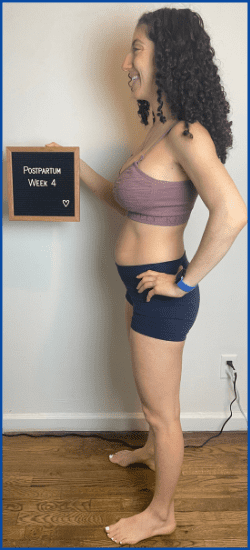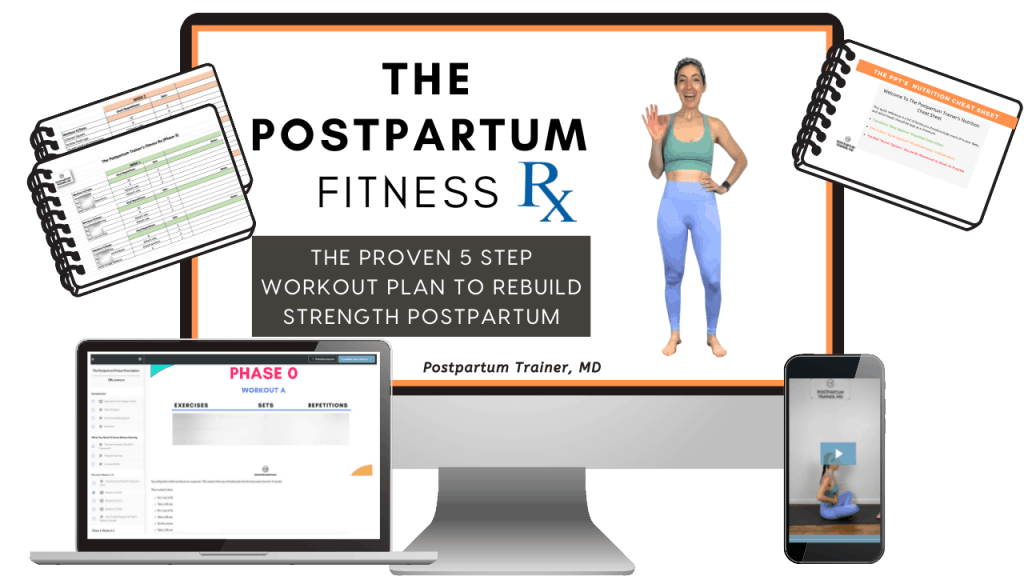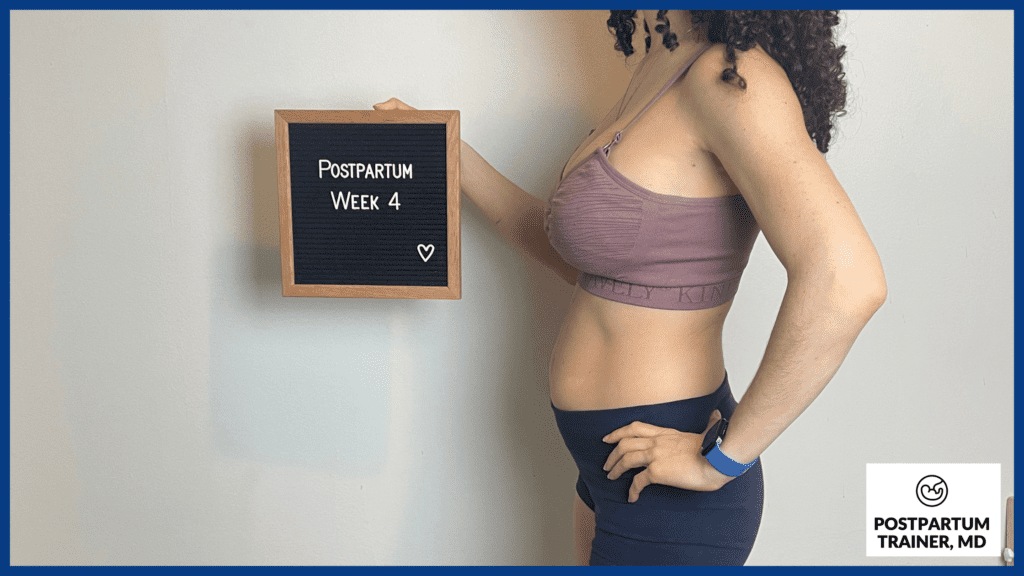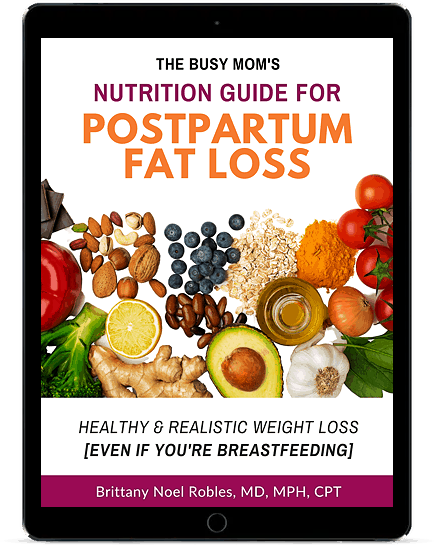
Pre-pregnancy Weight: 123 lbs
Weight at Delivery: 143 lbs (20 lb total weight gain)
Current Weight: 125.4 lbs
Now let’s go over how my week went and what to expect…
Energy Level: My energy levels started off poor this week, likely due to sleep deprivation.
My son was cluster feeding which meant more frequent breastfeeds, increased fussiness, frequent nighttime awakenings, and decreased sleep.
Eventually, he returned to his “routine,” and I am now getting some much-needed sleep.
My Emotions: I feel at my baseline, emotionally.
I am so happy to be a mom, and I am amazed at the amount of love I have for my son.
Postpartum Symptoms: I no longer feel uterine contractions during breastfeeding, which is a win!
But I am still experiencing some mild vaginal bleeding which requires a panty liner.
Postpartum vaginal bleeding can last up to 6 weeks, which is still normal.
However, suppose you experience heavy bleeding (soaking 1 pad every 1-2 hours). In that case, you may be experiencing a postpartum hemorrhage and should seek medical attention immediately.
Physical Changes: My belly has reduced in size dramatically. My stomach almost looks like it did in my pre-pregnancy state in the morning.
I checked myself for diastasis recti (a separation of the linea alba, the connective tissue between the rectus muscles), and thankfully I do not have it.
I still don’t see any stretch marks or signs of a linea nigra, and my belly button has returned to its pre-pregnancy shape.
Thankfully, my breasts haven’t been as engorged as in the immediate postpartum, and my nipples feel less sensitive when wearing clothing.
Diet: My diet has remained stable in the postpartum period.
I eat a well-balanced diet that includes oatmeal for breakfast (which may be great for breastfeeding) with many seeds and berries.
My lunch is usually a legume, whole grain, and plant-based protein, and my dinner is similar.
Lastly, I have several snacks throughout the day.
Check out my healthy diet for postpartum women here.
My husband and I are still doing our weekly date night (with the addition of a stroller).
Diet Modifications: Being an exclusively breastfeeding mom, I include items that may increase breast milk production.
These include:
- Oats
- Almonds
- Avocados
- Chia/hemp/flax seeds
- Carrots
- Sweet potatoes
- Water
Workouts: I have continued to follow The Postpartum Fitness Prescription Exercise Program, focusing on rebuilding core strength and the pelvic floor muscles in stage 1.
Specific exercises all new moms should do include:
- pelvic tilts,
- diaphragmatic breathing, and
- kegel exercises.
I also include resistance-based exercises as well as dumbbell exercises.
Before working out, I make sure to:
- massage my breasts to start the flow of milk using this awesome device that applies both vibration and heat
- empty my breasts using this hands-free manual pump while breastfeeding my baby on the opposite breast, or this portable hands-free wireless pump when I want to multitask before my workout 🙂
- wear a supportive nursing bra like this one
- put on these breast shells to collect any milk that leaks during my workout.
If you want to see examples of the types of workouts I am doing during my postpartum journey, check out my Postpartum Fitness Prescription video course.

*Be sure to speak with your health care provider before doing any physical activity or lifting at this stage of your postpartum journey.*
Other related questions
Why do I still look pregnant 4 weeks postpartum?
You may still look like you are pregnant four weeks after delivery for several reasons:
- Firstly, your uterus is still enlarged. Your uterus returns to its pre-pregnancy size and weight at approximately six weeks postpartum.
- You may be retaining water which can lead to bloating.
- Constipation and a lack of bowel movements can also cause your abdomen to look distended.
- Lastly, you may have diastasis recti (a separation of the abdominal muscles) which can alter the appearance of your belly.
If you still look pregnant after 6-8 weeks, you likely need to improve your diet and get to a healthy weight.
Check out my post on how to get rid of your mommy tummy here.
Here is what my postpartum body looks like at four weeks post-delivery.

Should I still be sore 4 weeks after delivery?
Yes, it is normal to be sore four weeks after delivery still.
You are more likely to be sore if you:
- had a c-section (this is major surgery!)
- sustained any laceration
- have pubic symphysis dysfunction
You should have a postpartum appointment scheduled 4-6 weeks after your cesarean birth or vaginal delivery. Be sure to discuss any soreness or pain with your healthcare provider.
How can I reduce my belly after pregnancy without exercise?
The most impactful way to reduce your belly after pregnancy is to improve your diet and nutrition.
Thankfully, this does not mean that you need to go on a traditional diet.
Instead, focus on improving the quality of the foods and drinks you are consuming.
I am a big advocate of adding healthy foods into your diet rather than taking foods away.
This is why I created the Nutrition Guide for Postpartum Fat Loss.

It is a step-by-step plan that tells you what to eat to lose fat healthily and sustainably without affecting your milk supply.
My top tips for a flat tummy after pregnancy
Achieving a flat stomach after pregnancy requires several things.
They are:
- Consume a well-balanced diet,
- Avoid consuming liquid calories
- Drink plenty of water
- Increase your physical activity levels
- Maximize your sleep quality
- Determine if you have diastasis recti (abdominal separation)
- Have patience (it can take time for the extra fluid in your body to resorb)
However, there is a possibility that your belly may never look the same after having a baby. Some women have a small pooch that never goes away.
In addition, if you have loose skin, your post-baby body may never look the same and may require surgical repair.
Feel free to check out my post on How To Get Rid of Your Baby Weight to learn more.
Anything else I should know?
If you have started some light postpartum exercise, it is important that you avoid placing excessive pressure on your abdominal muscles.
If you have diastasis recti, it is essential that you gently train your core muscles with progressive exercises.
Check out my 100 safe exercises for diastasis recti and the best pelvic floor exercises to learn more.
Final words on Postpartum Week 4
We made it through week 4!
How are you enjoying your new baby?
How is your postpartum recovery going so far?
Comment below and let me know!
Also, be sure to follow along with my postpartum belly week-by-week progress!
My Previous Baby Bump Updates
- My Week 1 Postpartum Belly Update (First Week Pictures)
- My Week 2 Postpartum Belly Update (Second Week Pictures)
- My Week 3 Postpartum Belly Update (Third Week Pictures)
Get Four Free Workouts To Help Strengthen Your Pelvic Floor & Heal Your Mommy Tummy!

Brittany Robles, MD, MPH, CPT
Brittany Robles is a full-time OBGYN physician, a NASM certified trainer, and a prenatal and postnatal fitness specialist. She holds a Master of Public Health degree in maternal health with a special interest in exercise and nutrition. She is also the co-author of The White Coat Trainer. Learn more about her here.
Sharing is Caring – Send This To A Mom In Need!
